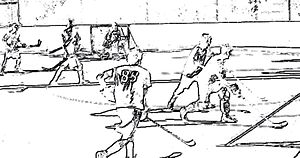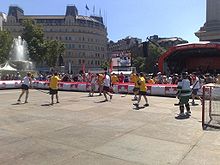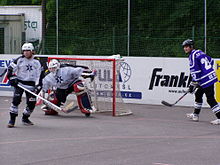- Street hockey
-
Street Hockey 
Photoshopped photo of teenagers playing street hockey.Highest governing body International Street and Ball Hockey Federation (International)
International DekHockey Tournament Association (United States)Nickname(s) dek hockey, ball hockey, in Canada some places call it "road" hockey Characteristics Categorization Primarily outdoor, indoor Equipment Required = A ball or a puck (most players use a ball but a small percentage use a puck), a hockey stick, a net. Optional = shin pads, gloves, helmet. Street hockey (also known as road hockey, dek hockey, ground hockey, ball hockey, or cosom hockey) is a variation of the sport of ice hockey where the game is played on foot or with inline skates or roller skates. The object of the game is to score more goals than the opposing team by shooting a ball or puck into the opposing team's net. In its most pure form, street hockey is always played on an outdoor surface (very often a street, parking lot, or other asphalt surface), thus the genesis of the name street hockey. In more organized forms, it is played in rinks which often were designed for roller hockey and can be indoor or outdoor rinks. There are also rinks built specifically for hockey played on foot, and these are referred to as dek hockey or ball hockey rinks. These rinks can also be used for roller hockey games. Street hockey in pickup form is generally played under the following guidelines, since there are no "official rules" for local pickup hockey:
- Teams are selected by captains via alternate selection of available players or all players put their sticks in a pile and the sticks are tossed out of the pile to opposing sides.
- Physical contact between players is extremely limited to avoid injury.
- Minimal amounts of hockey equipment by the runners are worn depending on player preferences.
- Players agree whether or not to allow slap shots and raising of the stick, both of which can incur serious injury to players since there is minimal equipment worn.
- Players determine whether to use a ball or a street hockey puck.
The term street hockey was started in the United States and is also used in the Atlantic Canada region. This wording is very closely related to the Canadian terms dek hockey or ball hockey. Some regions in North America use street hockey in reference to roller hockey, where inline or roller skates are worn to play otherwise the same game. Street hockey is generally played on foot, and when players use inline or roller skates to play, the sport becomes roller hockey. All this terminology can seem confusing to non-players and the general public, but ultimately is a simple case of semantics. General consensus amongst players of the sport is as follows:
Street Hockey has variations called dek hockey, ball hockey, and floor hockey. Roller Hockey is divided into two categories which are based on the type of skates used: Roller hockey (Quad) and Inline Hockey.
Contents
Gameplay
 A street hockey game in Trafalgar Square in London, England, held in conjunction with Canada Day celebrations
A street hockey game in Trafalgar Square in London, England, held in conjunction with Canada Day celebrations
Street hockey is based on ice hockey, and the overall purpose is the same: score more goals than your opponent by shooting the ball or puck into the opposing team's net using your stick. It is played on foot or with skates, usually on some outdoor asphalt surface, and usually with some kind of ball, most often a special hard rubber ball made for street hockey. In some instances a special puck designed for roller hockey can also be used. If a puck is used, generally the players agree for safety purposes to make every effort to keep the puck on the ground since the players generally don't wear protective head gear and if a puck were to strike a player in the head it could cause serious medical injury and damage. Generally, street hockey is played with little to no protective equipment, therefore intense physical contact is usually prohibited, and levels of physical contact are agreed upon before hand by the participants. The game does permit a level of physical contact similar to that allowed in basketball. Rules and playing styles can differ from area to area depending upon the traditions a certain group has set aside. In informal play, the game can often begin with a so called "NHL face-off", in which the two opposing centers hit their sticks against each other three times saying "N", "H", "L". Immediately following the "L" the two players fight to see who claims possession of the ball or puck. When street hockey is played in rinks, whether outdoor or indoor, it is often called "dek hockey" or "ball hockey" in the U.S. and Canada. Generally speaking, dek and ball hockey are played under more organized rules if they are not already being played as part of an organized league which has an official set of rules (see the section Leagues and governing bodies below).
The game can also be played on indoor basketball courts and/or gymnasiums. This type of game is called floor hockey and in organized leagues often has specific rules in place that differ slightly from outdoor street hockey. The walls or fencing of these "rinks" serve to keep the ball (or the less often used puck) in play similarly to the boards of an ice rink. Floor hockey also has its own variations called Cosom Hockey and Floorball.
In Toronto Canada, it is currently illegal to play street hockey on roads or in laneways. Fines are up to $55 but the law is rarely enforced. As of 2011 some city councilors are looking to change the by-laws.[1] A popular alternative to playing hockey on the street in Canada is to play in outdoor lacrosse boxes. The lacrosse boxes contain the same asphalt surface as the streets, but offers a more realistic feeling of hockey since the playing area is larger than the average street, in addition to having boards that surround the lacrosse box. The only downside to this is the smaller size of in-place lacrosse nets.
Similarly to lacrosse boxes, outdoor roller hockey rinks are becoming quite popular in public areas around the United States which allow for a place to play off of the sometimes dangerous streets. Outdoor roller hockey rinks are usually covered in a sport court surface so equipment does not wear down as quickly as on asphalt. Many are also covered to allow play during wet weather, and lighted for nighttime hockey. There are also a large amount of indoor rinks sprinkled throughout the United States and Canada. No official tally has been made as to the number of indoor rinks but the unofficial count is somewhere between 75-125.
Equipment
Overall, equipment for street hockey is based on that of ice hockey, but due to the general prohibition of body checks, most of the pads and other safety equipment used for ice or roller hockey are not worn or required to be worn in street hockey games. In pickup style games, most "runners" and/or "skaters" tend to play with some combination of the following: hockey gloves, shin guards, eye protection, athletic support, and mouth guards. Shin guards are often of the soccer type when the game is played on foot, though several companies now manufacturer and sell shin pads that are lightweight and durable which have been specifically designed for and are marketed for street and roller hockey. Goalies still typically wear equipment similar in appearance to their ice hockey counterparts for safety but partly also to help block more of the goal area. However, such goalie equipment used in street hockey is generally lighter than that used in ice hockey due to the reduced weight and density of the ball (or puck) that is typically used in street hockey as compared to the hard vulcanised rubber puck used in ice hockey. A strategy for some teams is to have the goalie not use bulky equipment for increased mobility and for added long range shooting accuracy, essentially being an extra attacker in the event they have possession of the ball.
A street hockey stick is similar to an ice hockey stick in shape and size, but made of materials that will better stand up to use on asphalt or a similar playing surface. It has two main parts, the shaft and the blade. The shaft is often made of aluminum or wood. The blade is usually made of polyurethane and attaches to the shaft by a screw. Other shafts are designed to have the blade inserted into the shaft and secured in place with a glue that requires heating to settle and solidify. Some street hockey sticks are made in one-piece form and are made out of plastic, polyurethane, graphite, aluminum, wood, or a blend of these and other materials. Ice hockey and inline hockey sticks can also be used, however, street hockey sticks are usually cheaper and are more common for this reason. In organized dek and ball hockey leagues, most players use more expensive sticks as the quality of game play is much higher than pickup street hockey.
In 1970 Raymond W. Leclerc created the No Bounce Orange Ball. These balls are partially filled with liquid, which reduces bouncing.[2] With the success of the widely-used orange ball for street hockey, many different color varieties have been introduced, such as yellow, red, pink, and even a glow in the dark ball. Several ball manufacturers now market the balls with the temperature range the ball was designed for on the packaging itself. Although there is no certified industry standard for the balls since no street hockey standards organization exists, all hockey ball manufacturers sell their balls according to the following temperature range: red/orange = hot/warm above 60 degrees, pink = cool - between 40-60 degrees, yellow = cold - below 40 degrees.[3] A tennis ball or whiffle ball can also be used as an alternative to the orange ball for street hockey, as it is much softer than the orange ball, therefore reducing the risk of injury.
The International Street and Ball Hockey Federation officially recognizes two types of ball for play: a hard (Pro) version for adult warm climate play and a soft (Street) version for non-summer play and younger youth age groups.[4]
Leagues and governing bodies
North America
There are now a number of organized street hockey/dek hockey/ball hockey leagues throughout the United States, in a number of cities, and for a variety of age groups. These leagues are played both indoors and outdoors, usually on rinks used also by roller hockey leagues. The International Dekhockey Tournament Association is the official governing body of street and dek hockey in the United States.[5] There are many U.S. Dek and Ball hockey leagues across the country. A high concentration exists in the Northeastern US with leagues such as The Hockey Dek in Springfield, PA, Leominster Dek Hockey in Leominster, MA, DekStar Dek Hockey in Pittsburgh, PA, Team Pittsburgh Dek Hockey in Pittsburgh, PA, and Nassau-Suffolk Dek Hockey on Long Island, NY. Organized leagues have also spread to the Southeast, Midwest, Northwest, and Southwest parts of the country as well. Many of these leagues were started by players who moved to their respective area from the Northeast.
The Canadian Ball Hockey League is a non-professional Canadian league in which teams from across Canada play in the U.S. under rules variant to standard dek hockey. There are also many regional hockey leagues throughout Canada including the York Central Ball Hockey League, Ball Hockey Ontario, Ball Hockey International, and SWO Ball Hockey. Thirty five National Hockey League and American Hockey League teams operate the NHL Street program, which allows children ages 6–16 to play street hockey free of charge.[6]
Other countries and international organizations
The International Street and Ball Hockey Federation is officially recognized as the governing body of the sport by the International Ice Hockey Federation. The non-profit was founded in 1993 and has provided international competitions since 1995.[7]
Street hockey is played in over sixty countries worldwide, and more than thirty of these countries have leagues that are members of the International Street and Ball Hockey Federation.[8]
Origins of the sport
It is believed that ball hockey took off when roads started getting paved in wealthier parts of North America around 1900. Lester Patrick, Art Ross and John Galante are said to have been some of the earlier practitioners of the sport in Westmount, a part of Montreal.[9]
Raymond W. Leclerc (the creator of the No Bounce ball) established basics for the game: a rink measuring 160 feet long by 80 feet wide, special lightweight protective equipment, a game that features no checking, and that all players ages 4 to over 50 could play. He then established an organization with key members Thomas Downey, Dave Kornik and Chris Housser ASHI/IDTA (American Street Hockey Institute/International DekHockey Tournament Association) with a special Street Hockey Rule Book to control the game.[10] Mr. Leclerc built a model site in 1974 to play and advance the game known as "The Home of Street Hockey" in Leominster, Massachusetts consisting of 3 outdoor rinks along with the headquarters and governing body of Street Hockey/Dekhockey. He is regarded as the founder and father of organized Street Hockey/Dekhockey in the USA and Canada.[11]
Championships and tournaments
Street hockey game in San Francisco, California
The game has advanced with dedicated indoor and outdoor rinks featuring special plastic modular sports surfaces. Tournaments continue all over the world.
Notable tournaments include:
- The Official US Nationals. The first sanctioned Official US Nationals were played in Leominster, Massachusetts, in 1976, won by the Leominster Rams. The first Internationals were also in Leominster and were won by the Niagara Falls Ontario Griffins.[12]
- Disney World in Orlando hosted the IDTA USA Cup Championships from 2006, 2007 & 2008 in the Field House[13]
- Street Hockey USA Men's C, D & Novice National Championship (established 1995) - Pittsburgh, PA
- Maple Leaf Cup is the host site of North American Youth Championships (established 1980) - Niagara Falls, ON
- I.S.B.H.F. World Championship - Various Locations
- World Outdoor Ball Hockey Championship (established 1995) - Barrie, ON
- Basinview Bedford Street Hockey Championship (established 2010) - Bedford, Nova Scotia
- Dorval Ball Hockey League- Longest running Ball Hockey League (established 1971)-Dorval, Quebec, Canada
- North American Championship - Harrisburg, PA (established 2005)
- Super Bowl Bi-Week Invitational - Harrisburg, PA
- King Of The Hill Tournament - Buffalo,NY
- Sin City Shootout Street Hockey Tournament - Las Vegas, NV (est. 2006)
- California Shootout Street Hockey Championship - Los Angeles, CA (est. 2010)
- World Outdoor Youth Ball Hockey Championship - Brampton, Ontario, Canada (est. 2009).
- The Street-Hockey Cup (established 1996) - Le Locle, Switzerland - Popular European tournament that accepts team entries from all over the world (204 teams in 2009).
See also
- Floor Hockey
- Ball Hockey
References
- ^ http://www.metronews.ca/toronto/local/article/781489--ball-drops-on-street-hockey
- ^ http://www.freepatentsonline.com/6645098.html
- ^ http://www.schoolyardpuck.com/2010/01/selecting-hockey-ball.html
- ^ http://www.isbhf.com/en/about-sport/street-and-ball-hockey/
- ^ http://www.idtadekhockey.com/AboutIDTA/IDTAHistory/tabid/62/Default.aspx
- ^ http://www.nhl.com/kids/pages/street001.html
- ^ http://www.isbhf.com/en/about-isbhf/isbhf/
- ^ http://www.isbhf.com/en/about-sport/street-and-ball-hockey/
- ^ [1]
- ^ http://www.idtadekhockey.com/LinkClick.aspx?fileticket=yPtKxN4PorY%3d&tabid=91
- ^ http://www.idtadekhockey.com/AboutIDTA/IDTAHistory/tabid/62/Default.aspx
- ^ http://www.idtadekhockey.com/TournamentsEvents/TournamentHistory/USNationals/tabid/84/Default.aspx?PageContentID=11
- ^ http://www.idtadekhockey.com/tournaments
External links
- International Street and Ball Hockey Federation
- XBHL - Ligue de Hockey Balle
- www.streethockeyusa.com/
- [2]
- [3]
- [4]
Categories:- Street hockey
- Street games
- Variations of hockey
Wikimedia Foundation. 2010.



